If you happen to be running a fast food restaurant and planning to design interiors for a shop, then reading this article shall be of highly useful to you. Take the inspiration from great design ideas ensuring that the interior design of the restaurant makes all the right sounds in the market and stands up to the demands of the current industry. It is very important to design the space in a thoughtful manner so that it is spacious, functional, and welcoming to open a fast food restaurant.
Consequently, having a well-thought-out area is essential. These incredible fast food shop interior design ideas will assist you in selecting the ideal elements for your space that will enhance it while maintaining the aesthetic and taste of your business. For a modern touch, consider integrating contemporary restaurant design elements that align with current trends.
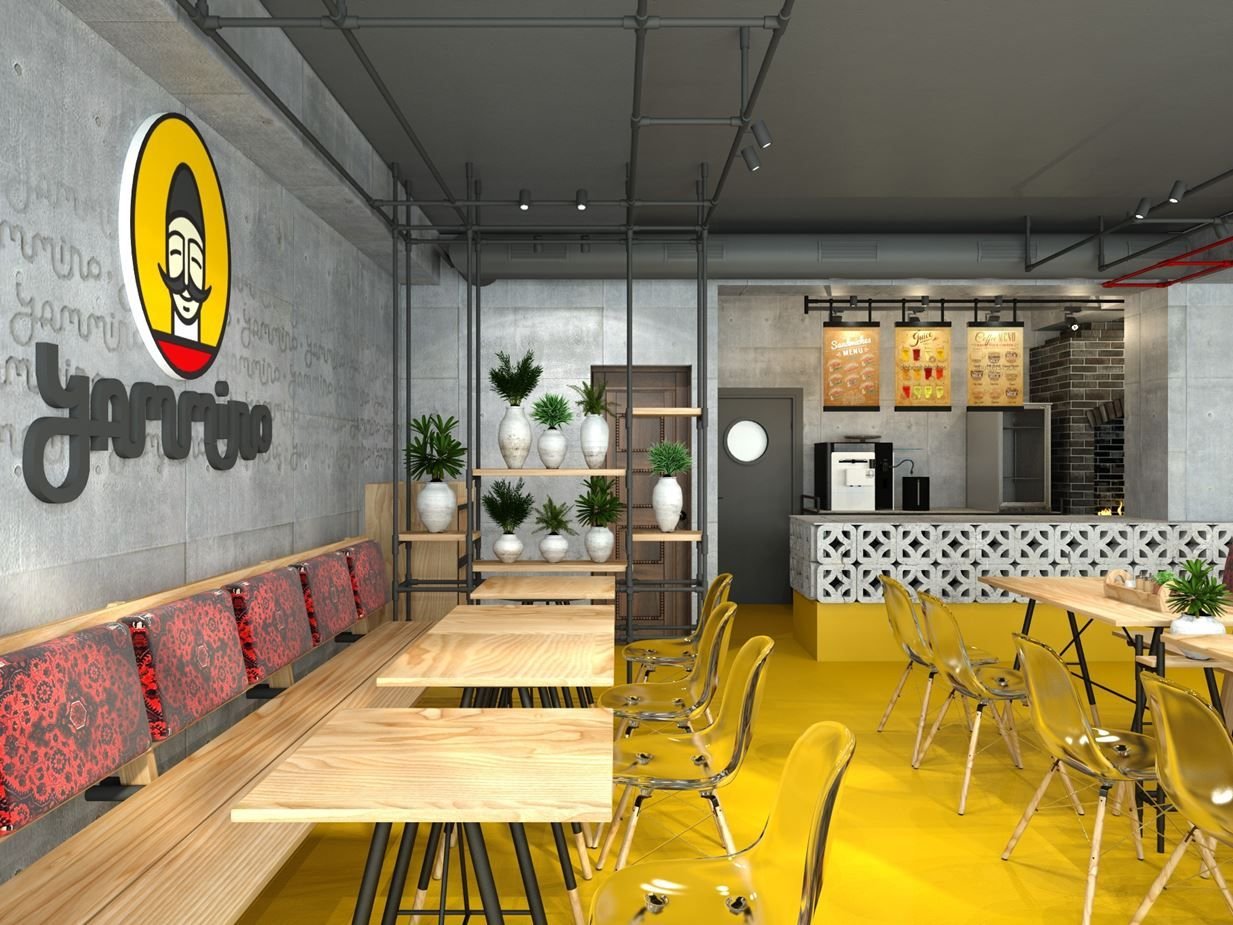
When entering a fast food restaurant, customers typically look at their order, either to dine in or take out. Fast food places are commonly regarded as institutions where food is quickly served, especially for those who have no time. The fact is that such places are supposed to serve services efficiently. In this regard, many people fail to appreciate the effort and thinking that goes into designing an interior of a fast food shop.
Table of Contents
Fast Food Shop Interior Design Ideas
It’s worth noting that fast food restaurants prioritize quick and efficient service over upscale dining. This is evident in their interior design, which emphasizes comfort and functionality to ensure customer satisfaction. Rather than a cookie-cutter style, these establishments are embracing a more personalized approach with diverse seating options and a dynamic layout.
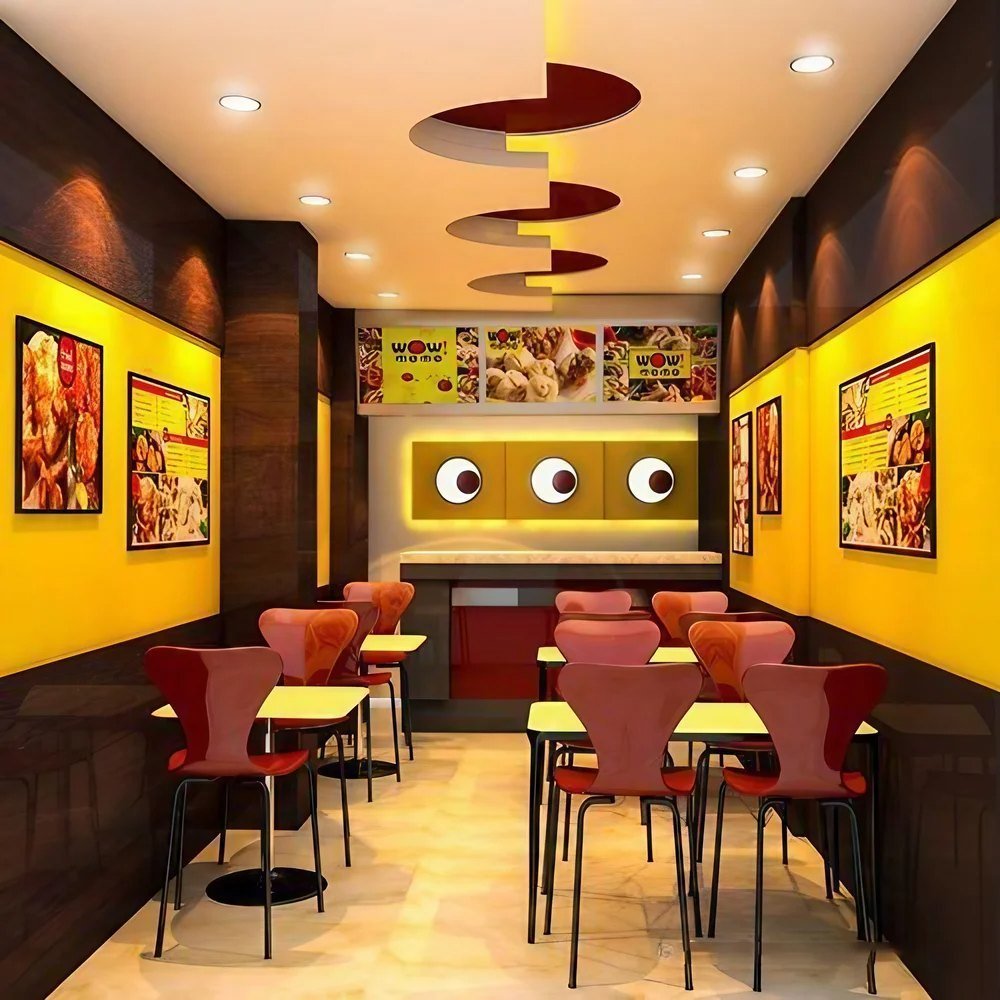

1. Identify trademark
You should design your fast food shop interior design around the company’s trademark. Branding is important for fast food shops. Customers tend to forget the brand when they visit fast food shops. Therefore, your fast food shop interior design should emphasize branding as much as possible.
2. Fast-food Restaurant Furniture
When establishing a fast food, the functionality is considered to be key in maintaining an efficient and smooth flow of customers. Tables are recommended to seat two to four people and are best square or rectangular in shape to make optimal use of space. Additionally, durable chairs should be selected to withstand heavy use.
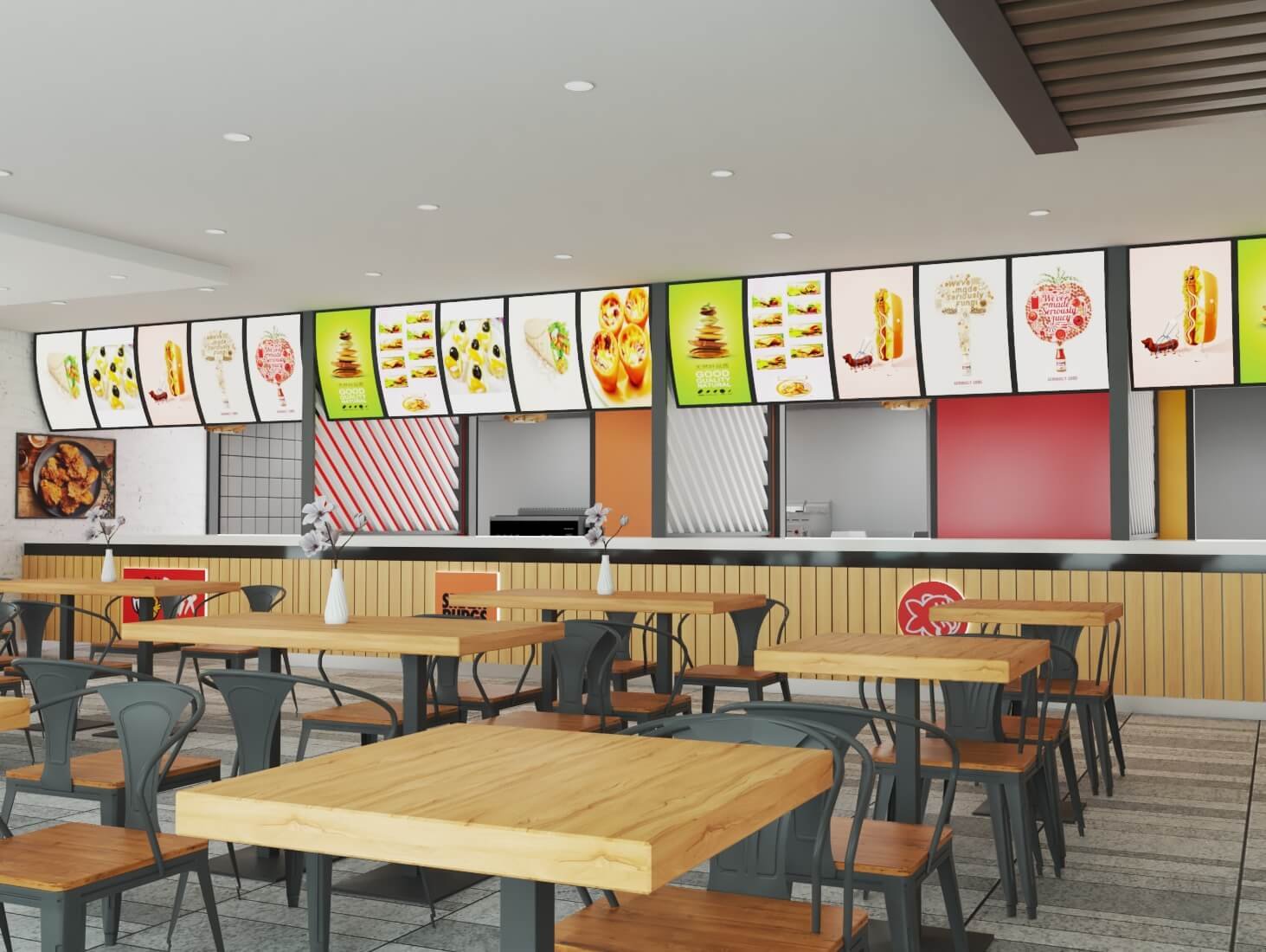

3. Fast Food Restaurant False ceiling
In a roomy fast food shop interior design, the addition of a false ceiling can greatly alter the overall look. This design element provides endless possibilities for adding style and improving the ambience. Whether through contemporary light fixtures or artistic elements, the false ceiling has the ability to completely transform the dining area. With creative ideas such as geometric designs, acoustic panels, or themed illustrations, customers can enjoy a one-of-a-kind dining experience.
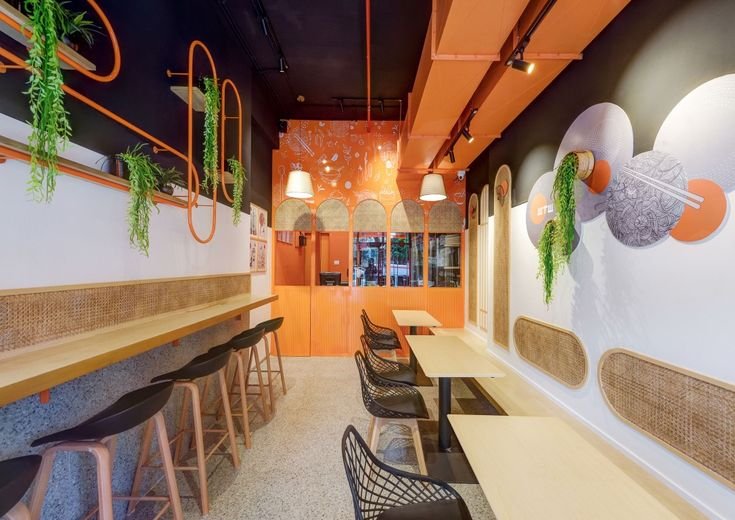

4. Fast Food Restaurant Lighting
Utilizing varying forms of illumination, both natural and artificial, is crucial in fast food establishments. Strategic placement of light sources can greatly enhance the overall ambiance of the restaurant. If the space allows for ample natural light through large windows, artificial lighting should only be utilized in specific areas. When selecting lighting for a fast food shop, opt for slightly brighter options than those used in traditional restaurants or cafes.
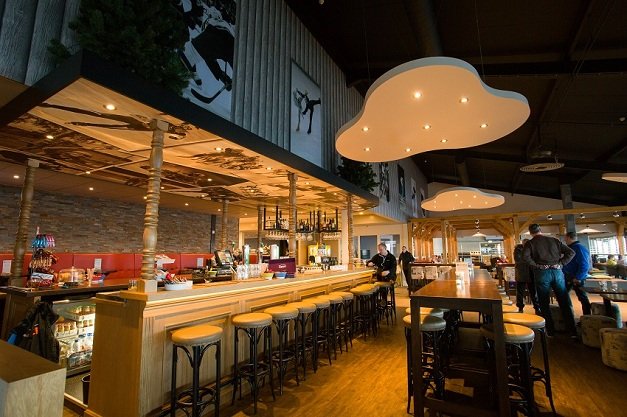

5. Bring uniqueness
For fast food establishments, making a lasting impression on customers who have limited time is key. This can be achieved by incorporating distinct interior design elements, such as unique furniture and color themes. By standing out from the crowd and leaving a mark on visitors, your establishment will be remembered.
6. Coloring
Color is very important when talking about interior design for fast food restaurants. The colors picked will depend on the identity of the restaurant and type. The color can be from natural to bold colors. Some restaurants use soft tones. A restaurant can use bright colors as well, which is highly eye-catching and demanding. Whichever color you pick, make sure you are representing your brand through colors. Colors must be bold for an appetite-enhancing effect in arousing a very energetic mood by guests.
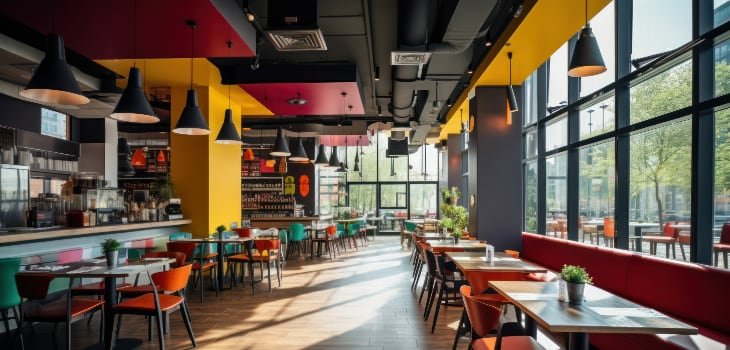

7. Infuse the Space with Greenery
You can’t go wrong with indoor plants. They’re fun to look at, but they’re also proven mood-boosters that can eliminate stress, and they can reduce air toxins by 87% in 24 hours. Infuse your restaurant with green goodness by placing plants on shelves, decorating an entire wall, or hanging them from the ceiling.
8. Choose a Theme
Selecting a cohesive theme for restaurant interior design plays a critical role in crafting a memorable dining experience. A carefully chosen theme guarantees that the decor resonates positively with guests, avoiding any overwhelming mix of styles. Maintaining consistency in all aspects of the theme—from furniture to color schemes and decor elements—creates a harmonious atmosphere that heightens the overall dining ambiance.
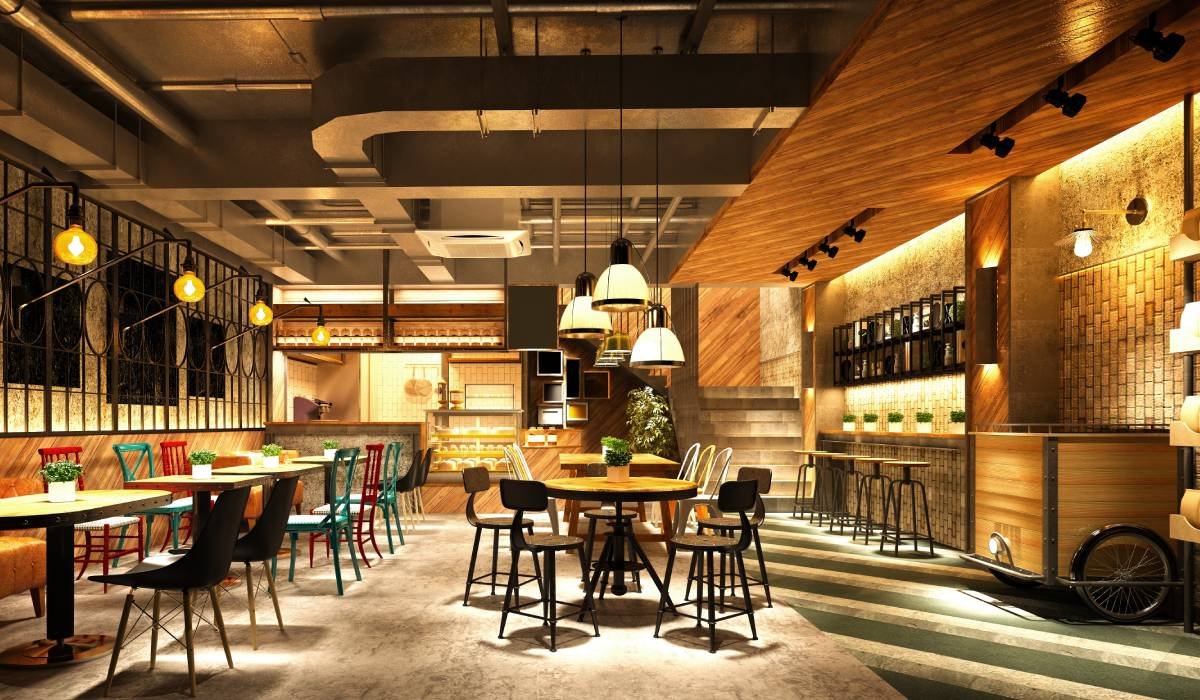

9. Make the design functional
Due to limited space, fast food shops must effectively utilize every available area in their interior design. Dividing seating into two sections allows for different customer preferences one for private or solo dining, and another for larger groups or families. This setup optimizes space usage while increasing customer satisfaction.
10. Fast food kitchen interior design
The high-paced nature of the fast food kitchens demands using high-quality, environmental-friendly materials because of the consantly coming orders. Appropriate ventilation is also essential to ensure proper air quality and temperature. Adequate numbers of cabinets are essential in providing storage for ingredients and equipment and thus order workflow.


11. Branding in the front
In fast food establishments, customers typically expect speedy service and tend to have short visits. While it can be difficult to establish a strong brand through interior design, prominently showcasing branding elements at the entrance can aid in customer retention. Adding company stickers on the front door or window improves visibility and reinforces brand recognition during brief interactions.
12. Design along with customer need
When creating the interior of a fast food establishment, it is vital to take into account both the range of products available and the intended audience. Familiarizing oneself with the demographic and tastes of customers aids in selecting an appropriate theme for the design.
13. Manage your space
Efficient space management plays a crucial role in fast food shop interior design, ensuring optimal functionality in each area. Before beginning the design process, careful planning is necessary to determine the best placement of every element. This includes strategic positioning of cooking stations, assembly lines, cashier counters, and seating arrangements to facilitate smooth workflows and customer traffic.
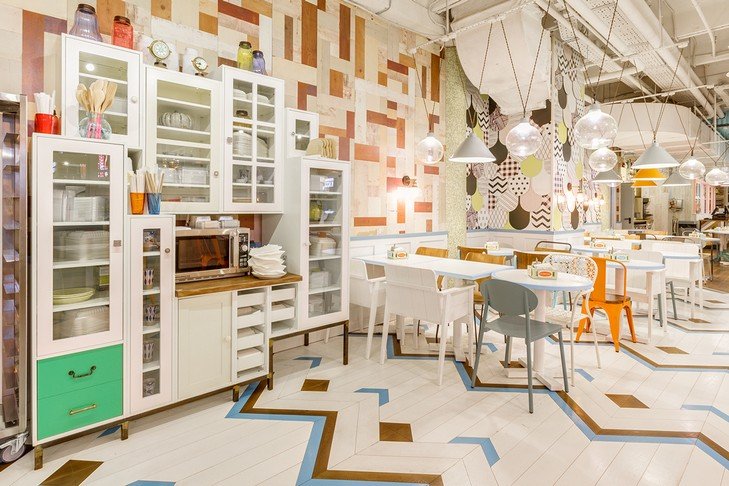

14. Use mirrors
Maximizing visibility is crucial in fast food shop interior design, and mirrors serve a dual purpose in achieving this objective. Strategically placed, they provide customers with multiple perspectives of the space, allowing them to observe the food preparation process and staff activities from various angles. This reinforces transparency and creates a sense of spaciousness and brightness, making the shop feel more inviting and expansive. Moreover, mirrors lend a glossy and contemporary flair to the decor, contributing to a vibrant atmosphere that complements the dynamic nature of fast-food dining.
15. Interior design for small shops
In a compact space within the food court, a small shop primarily focuses on taking orders and serving customers outside of its boundaries. These establishments often use bold color schemes to enhance their branding and draw attention in the busy food court setting. By utilizing counters and well-placed shelves, they effectively showcase their products, maximizing every inch of space. Designed for efficiency, the layout prioritizes quick service and an aesthetically pleasing display.


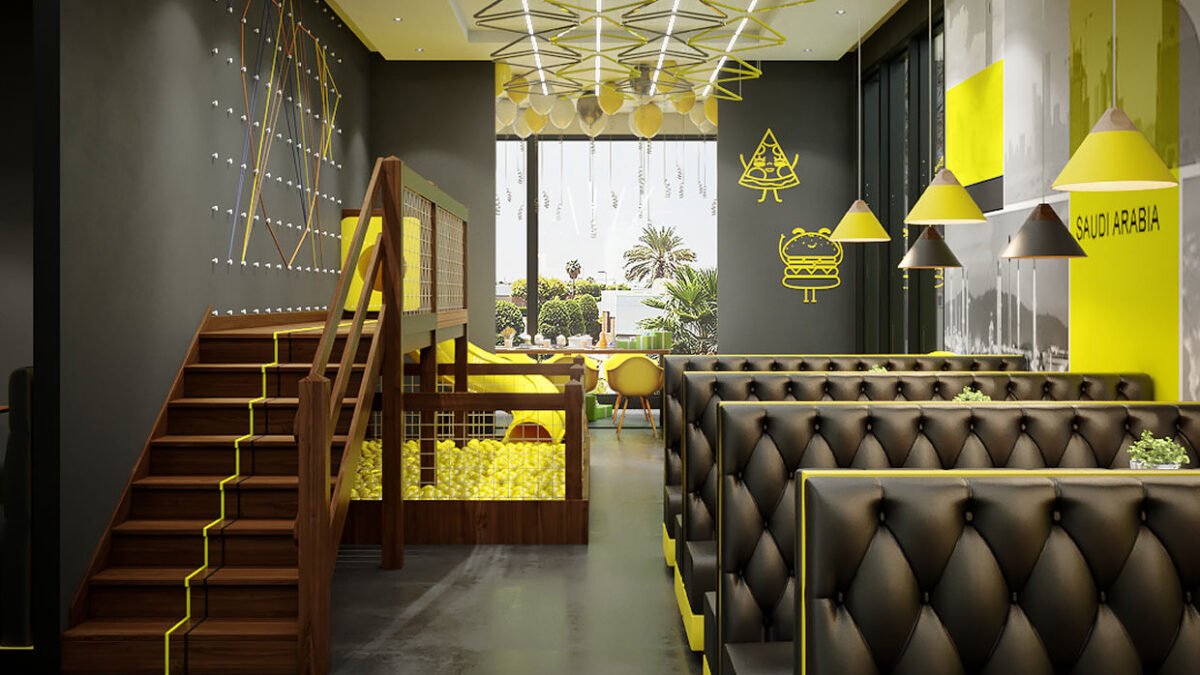

But the point is, standing out in today’s market is tough since certain design features are getting too common. Small things can have such enormous impact through details in your designs. The interior designer is busy perfecting little details and working behind the scene before revealing himself, for sure you wouldn’t know a single detail initially unless the detailed and focused approach gets clearer of surroundings in due inspection.
That means such approaches have always thrilled fast food shop developing an interior designing process while mainly gearing up toward enhancing experiences to that effect also among those involved as clients or customers. For a more comprehensive approach, consider using restaurant design interior elements that subtly elevate the overall ambiance and functionality of the space. Keeping the fast food shop interior design neat and tight is another objective. Adding creativity and uniqueness to the design will make the fast food shop interior design modern.
Read Next
10 Simple Restaurant Ceiling Design Ideas






